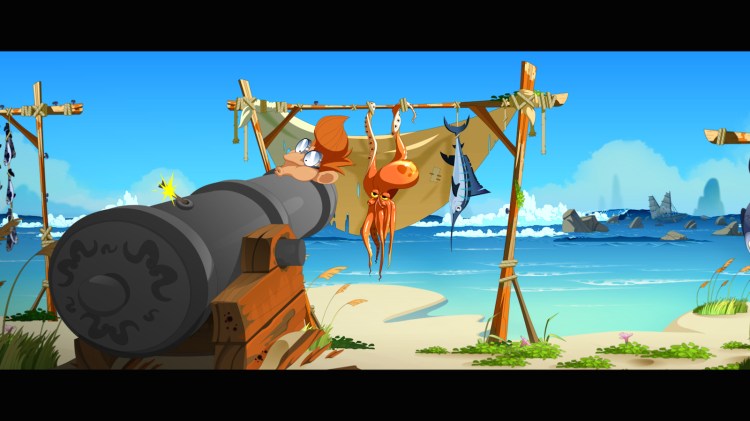Harold is unusual for a platformer. You control both the character (timing his jumps) and the obstacles in each level. As Harold’s guardian angel, you have to make sure he has a clear path to the finish line. Since it plays so differently from other games in the genre, Malek knew he needed something to ease players in and encourage them to stick with the level-shifting mechanics.
“I realized that you needed a little time to learn this new habit and break the old habit [of controlling just the characters]. … That’s why I was like, ‘OK, if the graphics suck, we’re dead,’” said Malek. “It was very clear in my head. I told my art director that we need to make a very, very nice [looking] game.”
Malek figured it’d take 10 to 20 minutes for players to understand the gameplay, and having great graphics to look at while they’re learning would lessen the pain of losing and help get them over that hump. 2D animation is his “second passion” behind games, so the studio settled on a 2D style with 3D elements. The goal was to make Harold look like something Disney or Warner Bros. would’ve done back when animators still painted on cels.
Moon Spider’s location played a huge part in making that come true. Disney used to have an animation studio based in Orlando. After it closed in 2004, many animators stayed behind (instead of moving to the studio in Burbank, Calif.) because of their families. Malek “was very surprised” to see their applications when he put the call out for animators.
The team (ranging from eight to 12 during development) quickly accomplished their animation goals, but they had a big problem. Harold only looked good in still images.
“It was terrible because when you see those kind of graphics, your brain expects to see everything moving perfectly at 24 frames per second. Because we saw that from Disney over the last 70 years,” said Malek. “When there was too much difference between … the graphics were very high but the animations were looking just like a video game. It was moving like crap.”
Though the self-funded company didn’t have much money, it went all-in on improving the animations. When I first saw Harold in a hands-off demo in 2012, it already looked stunning. But it took another two and a half years before Moon Spider would release it. The developers spent most of that time radically altering the difficulty level of the game. After letting people play Harold at gaming events like the Penny Arcade Expo, they realized that it was too hard.
The game they ended up releasing is “three or four times easier” than the 2012 version. Moon Spider redesigned over two-thirds of it, which also required making new art.
“It was a nightmare,” said Malek.
The studio didn’t throw any of that material away; if Harold becomes successful, some of those extra obstacles and assets could show up in a sequel. When I asked Malek if he’d do it again — after going through the laborious redesigns and spending years on polishing Harold — he wasn’t sure.
“I don’t know yet. It depends on the success of Harold, how gamers react to the game,” said Malek. “We know we did something weird and different — that we took a risk. We didn’t have any other solutions, because if we do another [first-person shooter] or another Gears of War-like [game], we have no chance because we can’t compete with the other companies. So we had to find something that’s different. Different means [that people may or may not like it]. We will see.”
Whatever they work on next, Malek told me one thing is certain: They’ll continue perfecting their 2D animation techniques.
[youtube https://youtu.be/zawwEWNbOXs]Unlike Hollywood’s soulless treatment of our childhood memories, games haven’t really tried to reinterpret our past obsessions. But as Action Henk and Harold show, they can remind us of what made our old toys and movies so great without relying on too many winks and nods.
But developers (indies and bigger companies alike) can explore so much more. Hell, I’m still waiting for my dream game: a slick-looking Power Rangers-inspired brawler with flashy transformations and giant robots.
VentureBeat's mission is to be a digital town square for technical decision-makers to gain knowledge about transformative enterprise technology and transact. Learn More




